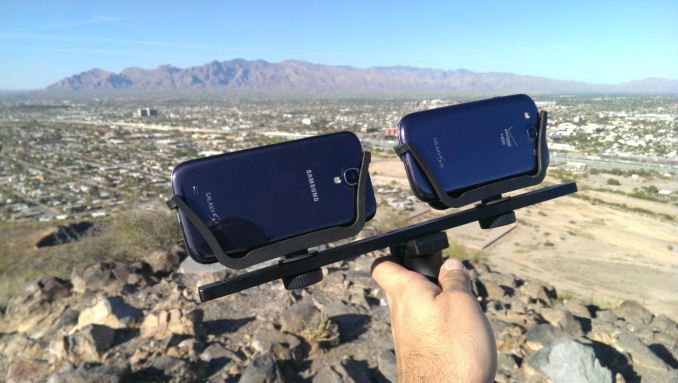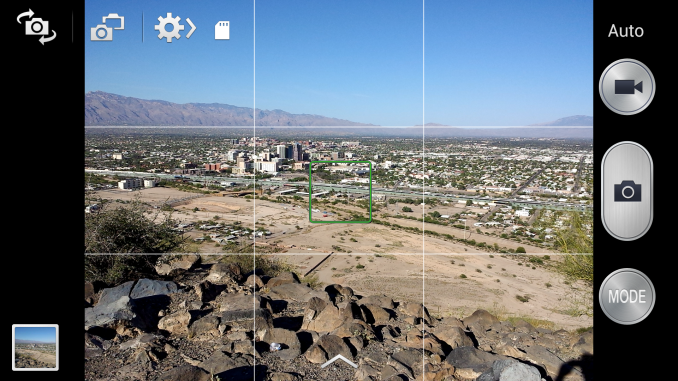Samsung Galaxy S 4 Review - Part 1
by Brian Klug on April 24, 2013 12:01 AM ESTCamera on SGS4
On the camera side Samsung is in an interesting position. The industry trend is overwhelmingly to go to more pixels and push the megapixel count up from 8 MP where most flagships sat last year to around 13 where they will sit this year. Samsung has to push that number to keep itself in a defensible and marketable position and at the same time deliver a camera experience that’s better than the previous year.
I published a table in the One review with the camera specifications from the previous generation. I’ve filled this in with confirmed information from the SGS4 review unit I have been taking samples with. With SGS4 Samsung does make some pretty considerable improvements, many of which undo some of the regressions that I described with SGS3. Focal length is now quite a bit longer, from the very wide SGS3 which was around 26mm in 35mm effective numbers, to 31 mm. This is a notable difference if you’re shooting with the two side by side, the SGS3 was always shockingly wide for a rear facing camera.
| Smartphone Camera Comparison - 2013 | |||||||
| HTC One | Samsung Galaxy S 2 | Samsung Galaxy S 3 | Samsung Galaxy S 4 | ||||
| Front Camera | 2.1MP | 2MP | 1.9MP | 2MP | |||
| Front Camera - CMOS |
OV2722 (1.4µm, 1/5.8") |
- |
S5K6A3 (1.75µm, 1/6") |
S5K6B2 (1.34µm, 1/6") |
|||
| Front Camera - Focal Length | ~1.59mm | 2.73mm | 2.7mm | 1.85mm | |||
| Front Camera - Max Aperture | F/2.0 | F/2.8 | F/2.8 | F/2.4 | |||
| Rear Camera | 4MP | 8MP | 8MP | 13MP | |||
| Rear Camera - CMOS |
ST VD6869 (2.0 µm, 1/3") |
S5K3H2YX (1.4µm 1/3.2") |
Sony/Samsung (1.4µm, ~1/3") |
IMX091PQ (1.12µm, 1/3.06") |
|||
| Rear Camera - Focal Length |
3.82mm (28mm eff) |
3.97mm (30mm eff) |
3.7mm (~26 mm eff) |
4.2mm (31 mm eff) |
|||
| Rear Camera - Max Aperture | F/2.0 | F/2.65 | F/2.6 | F/2.2 | |||
At the same time, F-number has improved dramatically, from the F/2.6 or 2.65 (I’ve seen both at times) aperture on the SGS3 to a much faster F/2.2. This dramatically improves the light collection abilities of the camera, by essentially a half stop. It’s difficult optical design to both keep the module thin enough to fit in the device without creating a huge bump (there’s a camera bump on SGS4, it’s there), increase focal length, improve F/#, and improve MTF for a better sensor all at the same time.
On the rear facing camera we see a Sony CMOS who continues to dominate the space, this time with an IMX091PQ sensor. On the front we Samsung’s own sensor, the S5K6B2 get used. Samsung also continues to go with a dedicated Fujitsu ISP inside the SGS4, this time it’s a new M10MO family which there isn’t a whole lot of information about. I suspect this continues to be done to mitigate the differences in SoC ISP between the APQ8064ab variant and Exynos 5 version and make tuning easier on Samsung’s camera team.
Imaging is increasingly a key differentiator for smartphones since it’s that device you always have on your person to take images with. For SGS4 camera is more of an emphasis this time around than it was with SGS3, which largely kept everything the same and just added software features. SGS4 brings better hardware and additional software features to do something with the hardware.
Outdoors in bright light the increased spatial resolution afforded from going from 8 MP to 13 MP helps. Samsung still does a lot of sharpening and there are halos around a ton of different features if you know where to look, but that’s the tuning they have opted for. I suspect we still are outresolving the sensor here, but I’m impressed with what I see with enough light. I took a lot of photos side by side with SGS3 and find SGS4 a notable improvement, but I’m not sure whether that’s just more damning commentary on SGS3 than anything else. I haven’t had time to put together many side by sides with buttons yet. I’ve been shooting with the HTC One on −2 sharpness since I prefer it that way, note that I accidentally left it this way with when making comparisons here since that’s still my daily driver until I can get an AT&T or T-Mobile SGS4 to use.
In lower light unsurprisingly we see the SGS4 offer better results than the SGS3 but still not quite as good as the HTC One. Samsung recently introduced low light shot on the SGS3 and Note 2, this feature carries over to the SGS4 but gets renamed back to Night Mode, even though behavior appears superficially to be the same. The SGS4 also introduces an auto night mode toggle, although this ships by default turned off. The mode automatically switches on night mode when it senses that you’re going to underexpose using the auto presets, I would advise basically leaving this on all the time. Unfortunately night mode introduces huge shot to shot latency that seems to be on the order of seconds — tap the button, capture runs, then there’s a progress bar that pops up while multiple exposures are ostensibly recombined into one image. You also have to be exceptionally steady to get an image without blur since it appears that this mode takes multiple images to get to the end goal — a better exposed image without tons of noise.
In the end there’s really no free lunch for anyone — you can temporally oversample (Samsung low light shot, or longer exposures with OIS like Nokia), or increase the size of your sampling area (larger pixels a-la HTC One), or do nothing and just give up unless you’re in a bright outdoor setting.
Samsung has introduced a bunch of new photo modes in the software on the SGS4, a number of which are actually pretty functional and awesome. There's the ability to create animated gifs from right in the camera, for example, where users paint a mask around the region they want animated from a short capture. This is essentially the same as Nokia's cinemagraph Lens from the Lumia 920, but it's still quite cool.
There's also dual camera, which lets you include a small overlay of the front facing camera atop the rear facing camera image. It initially struck me as a bit gimmicky but actually can be hilariously fun to share your face atop images to friends. It is also quite possibly the stuff of nightmares.
Panoramas on the SGS4 also are nicely put together and integrate continuously rather than get combined from a number of discrete images. The result is quite nice.
The user interface on SGS4 is a departure from the interface which has been present on previous Galaxy smartphones, and instead takes much UI/UX from the Galaxy Camera. Gone are the customizable toggles on the left side, instead options are in an expandable menu at the very top, and then another separate window. I got used to it pretty quickly but do miss the ability to customize the quick settings buttons on the left side and used to think that Samsung had the most powerful camera interface around. Things are moved around generally in a logical fashion however and I can understand how much this works to make transitioning between Galaxy Camera and SGS4 easy.
Video
When it comes to video, the SGS4 is records 1080p30 video at 17 Mbps H.264 High Profile.
I've done the usual thing and uploaded a sample to YouTube as well as our own servers for your inspection.
Video quality looks really nice and sharp on SGS4 from what I can tell by default. Anti shake (EIS in this case) is disabled out of the box, enabling it pops up a box warning you that stills captured during video record will be a different field of view.






























335 Comments
View All Comments
sigmatau - Thursday, April 25, 2013 - link
Oh and I own a Nokia 900 and am looking to go back to Android. My phone works great. The email is perfect, never a crash, and the UI is smooth and flood. What is lacking is software. I just bought a Camaro and can't even use the OnStar app for it. The battery could be better and the camera isn't the best. For work, though, it is perfect. Email and IE is tops for my job. Not sure why portal websites still don't work as well on Android. I, also don't understand why the screen (OLED made by Samsung) is unreadable in sunlight.Hrel - Wednesday, April 24, 2013 - link
Wow, what's with all the hate on Sprint? Even camping in Wisconsin I have service on Sprint. Who cares if the phone is made of metal or plastic or cow dung? You should ALWAYS be putting your smartphone in a case, ALWAYS! So I say use the cheapest durable material possible. Since it's ALWAYS in a case, it's fine. If you aren't putting your 600 dollar+ phone in a case NO, you are WRONG, it ALWAYS goes in a case, ALWAYS!MilwaukeeMike - Wednesday, April 24, 2013 - link
Alright, I had to jump in here... I'm a sprint user in Wisconsin and their network is terrible. They are the only major carrier who's speed tests must be measured in kpbs instead of mbps to avoid the heavy use of decimals. He put a caveat on the review because a slow network makes the phone work longer and hurts battery life and because Sprint's network is so much slower, you'll see much better results from other networks. He made the right choice to leave out a 3G browsing graph because it wouldn't be an accurate showing of the phone's battery life.... especially since his other phones are on other (better) networks.You do realize some people care about materials... if you don't, fine use a case. but if you do care, then the metal phones are nicer. Apple's had success with their metal phone too you've probably noticed.
Hrel - Wednesday, April 24, 2013 - link
Apple had success because it's Apple. People who buy Apple buy Apple, they could release a phone powered by human blood and people would buy it. If you live near MIlwaukee or Green Bay then I'm not sure what you're talking about. If you live podunk then yeah, you need Verizon. But Verizon is 110/month. Virgin Mobile (Sprint) is 35/month. I'll take a slower network over 900/year.dolo4delf - Wednesday, April 24, 2013 - link
I have an Ipod Touch...love it....would not buy an Iphone though...kyuu - Wednesday, April 24, 2013 - link
No, you are wrong. Do what you like with your own phone, but I'm not putting mine in a case -- adding extra weight and thickness, ruining the in-hand feel, or covering up the exterior -- because you say so.And no, I don't own an iPhone.
sigmatau - Thursday, April 25, 2013 - link
Go shove your case! You are wrong! If your phone needs a case, than it is a sorry POS. The only case I've had for a phone was a terrible Samsung phone. Not for a blackberry, not for an iphone, not for my Nokia 900. So you are wrong. Put your laptop in a case when you use it.gnx - Wednesday, April 24, 2013 - link
Glad to hear the camera is an upgrade. Looks like Sammy was primarily concerned about comparison with the Iphone5, focused on pixels, aperture, software enhancements (including aggressive night mode), etc. I have to admit, since I take photos oft in well-lit situations, outdoors and indoors, and don't take photos with friends in low-light bars often, this is what I'm looking for as a daily driver. Also, less noise in background colors is an important plus for me, since I blow up parts, and crop out others for the optimal photo to share.Hopefully Klug will update his review when he gets a hand on the international Exynos Octa version? I'm going for that one, even if I have to lose LTE, since it's more useful for travel abroad, and hopefully will have better CPU/GPU performance and maybe battery too. I don't think there's been a actual customer product with ARM's Big.Little architecture (Exynos Octa being a variant), so I'm looking forward to an analysis by Anandtech on that.
Battery is my third concern, but when you can buy a spare battery and chargers that charge both the phone and the battery at the same time, it becomes a mute problem.
AMOLED is always something of a hate-love relationship. It's oversaturated and power-hogger in browsing mode (cause of the white background), but I have to admit, unlike a laptop or desktop screen, in the relatively cramped phone, it does make the screen pop-out more. Especially with the minimal bezel on this SGS4! I remember each time I'm in carrier stores, the AMOLED screens really catch one's eye when side by side with a LCD screen, even though under further use, the LCD seems to have better clarity, even it it seems subdued. But what I really want to know is if the AMOLED tech used on this SGS4 has matured enough that we don't need to worry about gradual burn-in, which was a real problem in older AMOLED screens.
Touchwiz is still too chaotic for me, but at least I can always install a custom launcher. Just wish they provided an optional color theme for settings, etc, but that's probably asking for too much. At least, if this sells well, we'll have ample support from XDA developers.
Plastic is the bummer here. Gees, is it really impossible to build removable batteries and sd cards without resorting to plastic? My originally HTC Nexus One had a removable backcover. Surely, Samsung can do something close too? (No?) Or has Apple cornered so much of the aluminum supply, that it's prohibitively expensive and detrimental to timely large scale production? (as some Sammy sources imply?) Can't help wondering, with the competition from the HTC One, the next Note III due this fall will have a metal or some other upgraded case.
In anycase, further reviews on international SGS4 models with different parts, and updated reviews for the HTC One with US carriers and updated software would be appreciated!!
Thanks, Anandtech!!
BestPal - Wednesday, April 24, 2013 - link
Brian, you guys always do the best reviews, thanks!Y'all also do the most technically comprehensive reviews too, which is great for us gear heads :)
In that vain, and since you have the Sprint variant, I would like to ask a bit of a technically curious question I have about the Sprint variant...
Sprint is now finally going back to using removable SIMs on their GSM-capable devices, which is awesome for folks who travel overseas. Even better, Sprint is fairly liberal about unlocking their devices, albeit with having the OEM modify the device such that it won't do GSM inside the US on US bands, which is a long-standing Sprint thing but is absolutely fine. The main thing is that it allows using the device with a foreign SIM outside the US. However, on this device Sprint appears to have had Samsung do something strange, which is even though the device passed the FCC with UMTS 850 in it, Sprint appears to have requested Samsung to disable it, EVEN FOR overseas usage, leaving it with only UMTS 1900 and 2100. For those of us who frequently travel to South America (and a bunch of other places in the world too), crippling that band for overseas use is very problematic. Any idea why Sprint did that? Since in Sprint's case that band won't be useable in the US anyway. Anyway, I can think of no good reason to do this.
antef - Wednesday, April 24, 2013 - link
Samsung doesn't know how to do UI and they prove that with every phone or tablet they put out. TouchWiz is like Windows XP and IE6 with a million extra toolbars installed. The hardware menu key is awful and if they stopped and thought about it for a few moments they would realize why it's bad for new users, the platform, and those switching between tablets and phones. As the owner of two Samsung Nexus devices, I think they're hardware is great, but they can't get it together with usability and UI.